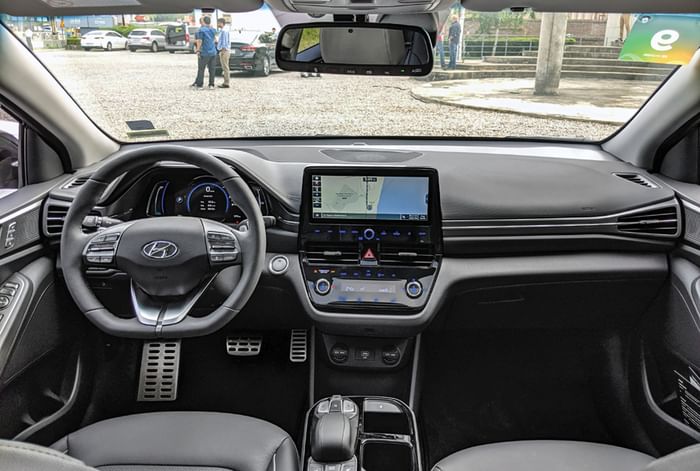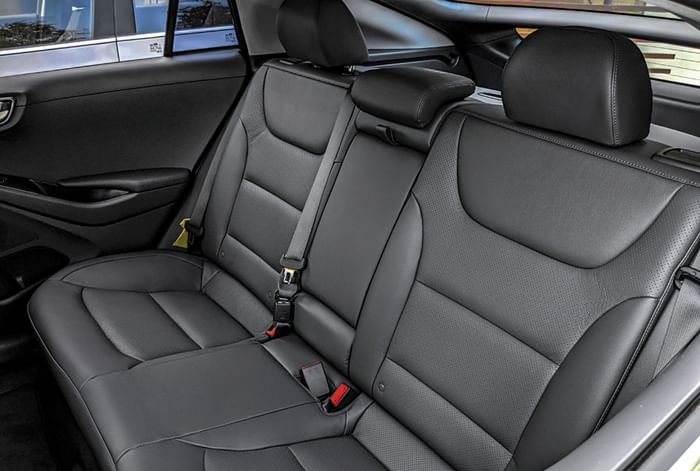The Hyundai Ioniq is a landmark vehicle of sorts; it’s the first car in the world to offer the choice of a hybrid, plug-in hybrid and full-electric powertrains – an important fact, given where the future of the automobiles lie. It’s ironic then that with India’s focus on EVs, none of these versions are expected to make it here. The obstacle is the high price tag it will carry, and so Hyundai’s first electric model in India will be the Kona SUV; the premium on EVs is easier to bundle with the premium customers pay for SUVs.
Hyundai says the Ioniq EV could make it here only if the electric market matures and something can be done to address the pricing. So, if it all works out, will the Ioniq be a good fit for India? We went to Korea and got behind the wheel of one to find out.

The Ioniq is a good-looking car, and thanks to the massive sealed-off grille area, there’s no mistaking it for anything other than an EV. The design of the lights and wheels too gives the impression of something unconventional and represents the future of mobility. However, given its landmark status, I wish the styling was more unique and individual; its overall stance and the rear with the split windscreen are a bit too reminiscent of the Toyota Prius. But that said, the Ioniq comes off as a lot less edgy and better balanced.

On the inside too, there’s a good sense of balance, and although there are a few sporty touches that seem out of character – like the flat-bottomed steering wheel and aluminium pedals – it all works. Giving away its electric nature is the digital instrument panel that has a power consumption vs charging indicator, and a battery gauge flanking a large speedo, and trip display. With no gearbox, Hyundai has done away with the lever for the drive selector and instead opted for buttons for park, neutral, drive and reverse.
In terms of equipment, the Ioniq is well specced; there aren’t any ‘electric car’ compromises that we are so used to seeing. There’s electronic climate control, heated and cooled seats, a touchscreen with Android Auto and Apple CarPlay, electrically folding mirrors, keyless entry, auto lights and wipers and various autonomous functions like adaptive cruise control, lane departure warning and autonomous emergency braking.

Space inside is pretty generous and there is good legroom, so even taller occupants will be comfortable here. Headroom at the front is good but the sloping roofline makes the headroom a bit constricting for taller passengers.
The Ioniq is powered by 120hp motor that puts out a healthy 295Nm of torque, and like every other electric motor, max torque develops right from the start; in fact, with a heavy foot, you’ll see traction control kicking in quite early to prevent wheelspin. That little bit of excitement aside, it feels like every other EV; power comes in strong and instantly, and then stays linear throughout, and so acceleration feels brisk initially and a bit sedate above 60kph. Hyundai claims a 0-100kph time of 9.9sec in Sport mode, which is pretty quick on the whole. Normal mode takes 10.2sec, which is still very respectable. There is also an Eco mode which limits performance further in favour of an extended range.

Speaking of range, the Ioniq delivers a 200km driving range, according to the US EPA rating. Charging time stands at 4hr 25min for a full charge, while fast charging can get the car to
80 percent in about 30min.
The Ioniq is set up to be an urban car. The steering doesn’t feel very connected and communicative but it is light enough for an easy commute around town with Sport mode weighting it up a bit more, should you prefer it. Braking was a pleasant surprise. While still not as natural as a conventional car’s, the bite isn’t as sudden, and the blend between the motor braking and the disc brakes is smoother than that of a few other electrics I’ve tested. You can also vary the level of engine braking via the paddles behind the steering wheel. I found the strongest setting a bit too aggressive, so the mid setting is what I used most often, and here too you can drive around using just the accelerator pedal most of the time, slowing down a fair bit solely with motor retardation. You can also hold onto the left paddle and bring the car to a full halt; it’s what Hyundai calls the ‘one-pedal driving system’. It feels strange at first but you soon get used to it; I’m, however, dying to see how it will feel in our start-stop traffic back home.
Of course, it’ll be a while before that happens because, as I mentioned, Hyundai is in no hurry to get the Ioniq here. If the market does mature and it can work out a fitting price, the Ioniq would make for a very good EV, actually a very good car. It’s comfortable and spacious, and loaded with all the creature comforts you need. Performance is quicker than some of our conventional engine sedans and the range, while not enough for a long weekend trip, will be more than adequate for most daily urban commutes. It would actually be a shame if the Ioniq won’t see the light of day in India.
| Hyundai Ioniq: Technical specification | |
|---|---|
| Length | 4470mm |
| Width | 1820mm |
| Height | 1450mm |
| Wheelbase | 2700 mm |
| Kerb Weight | 1475 kg |
| Motor | Permanent Magnet Synchronous Motor |
| Power | 120hp |
| Torque | 295Nm |
| 0-100kph | 9.9sec (claimed) |
| Battery Type | Lithium-ion polymer |
| Battery Capacity | 28 kWh |
| Range | 200 km (US EPA) |
| Charging Time | 4hr 25min (to 100%) and 30min (to 80%) via fast charge |
Click here for Hyundai India models, prices, reviews, images, videos and more




































